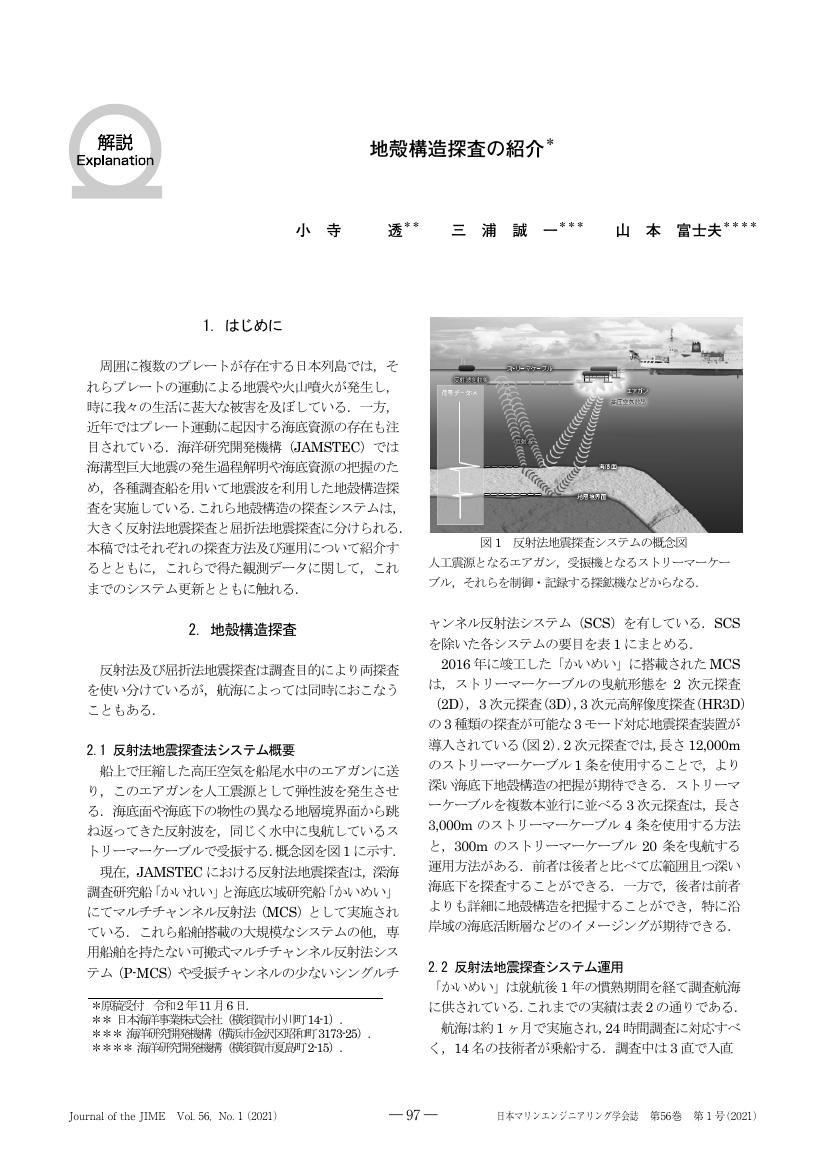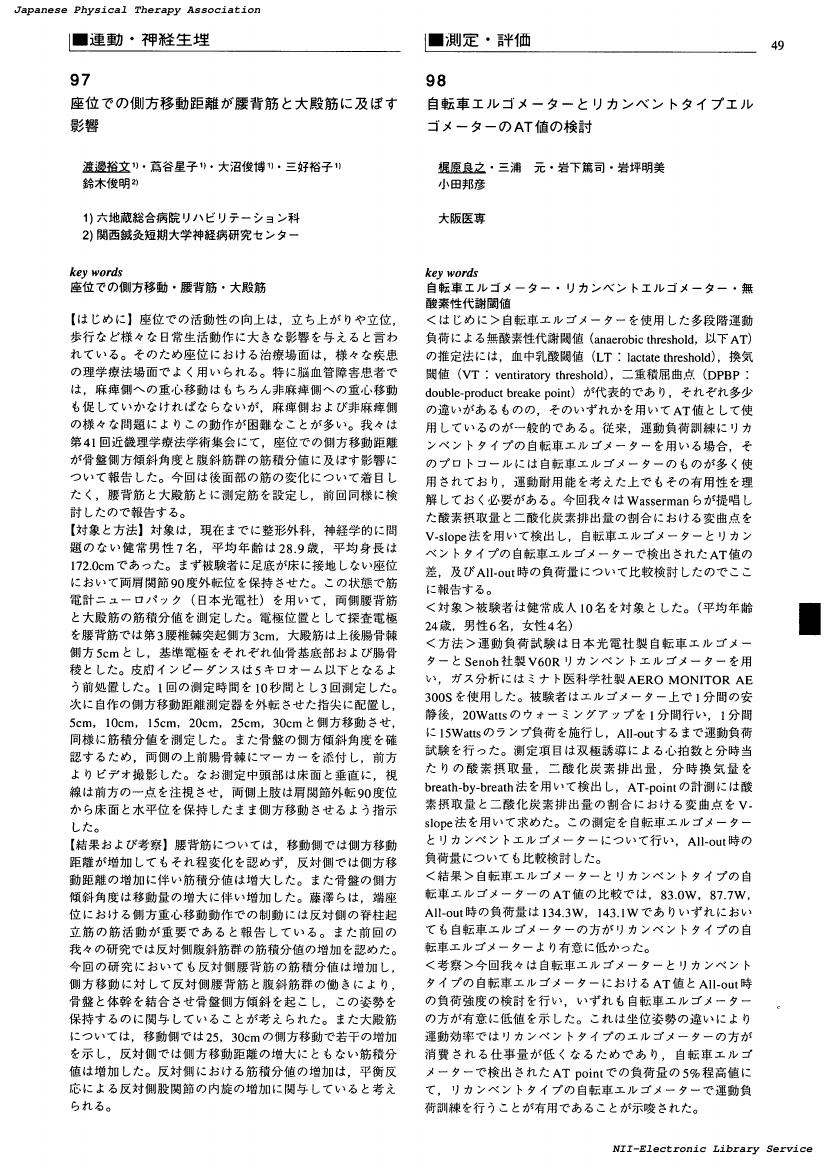1 0 0 0 OA 追悼 佐藤次高先生
- 著者
- 三浦 徹
- 出版者
- 公益財団法人 史学会
- 雑誌
- 史学雑誌 (ISSN:00182478)
- 巻号頁・発行日
- vol.120, no.6, pp.1154-1156, 2011-06-20 (Released:2017-12-01)
1 0 0 0 OA 食事を想定したリーチ動作
- 著者
- 三浦 雄一郎 長崎 進 福島 秀晃
- 出版者
- 関西理学療法学会
- 雑誌
- 関西理学療法 (ISSN:13469606)
- 巻号頁・発行日
- vol.15, pp.7-11, 2015 (Released:2016-01-06)
- 参考文献数
- 9
Table manners are as important as just eating a meal. With the spread of food culture, Japanese culture has been influenced by overseas eating habits. The upper limb is moved into a certain position to have a meal. When performing functional therapy, a knowledge of these movement chains is important because the shoulder, elbow, forearm, wrist, and finger joints are mutually related. In clinical practice, the relationship between the joints is immediately noticeable by movement compensation that is generally recognized and helpful to gauge the effects of physical therapy. However, the exercise chain of the forearm, elbow, and shoulder joints may not display obvious movement compensation, thereby making it difficult to detect functional decline. The movement used to pick up food with chopsticks, a fork, or a hand during meals is known as the reach movement. There are two types of reach movement: of a range that is smaller than the length of the arms, or beyond the length of the arms. Generally, the movement used during meals is mainly of the former type, but the latter type may also be used in some food cultures. This report describes the exercise chain of the forearm, elbow, and shoulder joints, and the movement chain involving the trunk and the shoulder girdle, in consideration of these factors.
1 0 0 0 OA Si(111)上のアルカリ土類金属吸着と表面再構成に関する電子状態の研究
- 著者
- 金城 政信 三浦 雅典 折本 裕一 青木 百合子
- 出版者
- 公益社団法人 高分子学会
- 雑誌
- 高分子学会予稿集 第56回高分子学会年次大会
- 巻号頁・発行日
- pp.878, 2007 (Released:2009-05-28)
Siの(111)表面上への種々の金属原子の吸着およびそれに伴う表面再構成に関して吸着機構、被覆率における構造変化に着目し、モデルに対して理論的解析を行い、量子化学的見地からその考察を行った。
- 著者
- 三浦 洋
- 出版者
- 北海道大学哲学会
- 雑誌
- 哲学 (ISSN:02872560)
- 巻号頁・発行日
- vol.44, pp.231-239, 2008-02-29
- 著者
- 三浦 励一 Reiichi Miura
- 出版者
- 国立民族学博物館
- 雑誌
- 国立民族学博物館調査報告 = Senri Ethnological Reports (ISSN:13406787)
- 巻号頁・発行日
- vol.84, pp.35-50, 2009-03-31
1 0 0 0 OA ジョン・フェンネル著・宮野裕訳『ロシア中世教会史』
- 著者
- 三浦 清美
- 出版者
- 日本ロシア文学会
- 雑誌
- ロシア語ロシア文学研究 (ISSN:03873277)
- 巻号頁・発行日
- vol.50, pp.163-175, 2018-10-15 (Released:2019-05-22)
1 0 0 0 OA 地殻構造探査の紹介
- 著者
- 小寺 透 三浦 誠一 山本 富士夫
- 出版者
- 公益社団法人 日本マリンエンジニアリング学会
- 雑誌
- マリンエンジニアリング (ISSN:13461427)
- 巻号頁・発行日
- vol.56, no.1, pp.97-100, 2021-01-01 (Released:2021-01-27)
- 参考文献数
- 3
1 0 0 0 OA サラワク・シブにおける華僑社会の形成と変容、対日歴史記憶に関する総合的研究
日中戦争前期(1937-1941)、中国からの短波ラジオ、教科書、抗日宣伝雑誌、映画、歌曲などを通じて、サラワク華僑に対して、民族意識や祖国の抗戦が宣伝された。これに応え、華僑は救国義捐金運動を展開した。太平洋戦争時期(1941-45)には、サラワクは激戦地とはならず、華僑を含む現地住民への大規模な虐殺は概ね発生しなかった。しかし、日本の軍政は「ビンタ」や犯罪容疑者に対する酷刑などにより威圧的様相を強く呈した。また、資源の収奪、既存の流通網の寸断、統制経済は、民生を混乱に陥れた。中国から注入された抗日戦争のイメージと太平洋戦争での経験が複合することにより、華人の対日歴史記憶が形成された。
1 0 0 0 OA インターバル水泳中の休息期の違いによる心拍数及び水泳スピードの変動
- 著者
- 宮下 充正 松井 秀治 三浦 望慶 星川 保 亀井 貞次
- 出版者
- The Japanese Society of Physical Fitness and Sports Medicine
- 雑誌
- 体力科学 (ISSN:0039906X)
- 巻号頁・発行日
- vol.18, no.1, pp.1-8, 1969-03-01 (Released:2010-09-30)
- 参考文献数
- 8
- 被引用文献数
- 1 1
The purpose of this study is to conduct the examination of heart rate and speed variations with respect to the various interval trainings of swimming. One trained, one post-trained and one untrained swimmers were employed for this study. The experiment was conducted during the summer of 1968. The temperature of atomosphere varied from 30°C to 33°C and that of water from 27°C to 29°C.The data of heart rate were obtained from the record of ECG. Two electrodes or ECG consisting of silver cups of 10mm in diameter were attached to the skin over sternum. In order to avoid mechanical and electrical disturbances, the electrodes were tightly fixed through the following procedures;1) The electrodes were pasted on cleaned skin with ECG jelly.2) The adhesive plaster was placed over the electrodes.3) The adhesive plaster was coated with wax.The wire of 20 meters was used to connect the electrodes and the recorder. On trial of interval training was consisted of two phases; 1) The active phase....To swim 50 meters according to his swimming ability. 2) The rest phase...To take a 0, 5, 10, 20, 30, 45 or 60 seconds interval between each 50 meters swimming. Each trial of training was repeated ten times.Results are as follows;1) The longer the rest period is, the higher the swimming speed is.2) All swimmers swim 50 meters at 60-80% of their maximum speed and the percent of the trained is higher than that of the untrained.3) Maximum heart rates of the trained, the post-trained and the untrained during tenth swimming are 188, 180 and 173 respectively, which are the same in every trial.4) Decreasing rates of heart rate during the rest period are 10 under in 5-10 seconds interval, 15-25 in 20-30 seconds interval and 20-50 in 45-60 seconds interval,
1 0 0 0 OA チリにおける近年の政治社会変動とボリッチ政権-代表制の危機という視点から
- 著者
- 三浦 航太
- 出版者
- 独立行政法人 日本貿易振興機構アジア経済研究所
- 雑誌
- ラテンアメリカ・レポート (ISSN:09103317)
- 巻号頁・発行日
- vol.39, no.1, pp.1-17, 2022 (Released:2022-07-31)
- 参考文献数
- 9
2021年12月に行われたチリの大統領選挙の結果、急進左派連合のガブリエル・ボリッチが勝利し、1990年の民主化以来初めてとなる、左右二大連合に属さない勢力による政権が誕生した。本稿では、代表制の危機という視点から、2010年代のチリの政治社会変動、新しい政治勢力が台頭した2021年選挙、今後のボリッチ政権の課題について考察することを目的とする。チリは、既存の左右二大連合政治に対する不信を起点に、投票率の低下、抗議行動の活発化、2019年のチリ史上最大級の抗議行動「社会の暴発」を経験してきた。さらに近年では、代表制の危機の表れとしてポピュリズム的性格をもった政治勢力の出現もみられ、新しい政治構図のもとで2021年大統領・議会選挙が行われた。ボリッチ新政権には、新自由主義からの転換という大きな目標があるが、その目標の実現のためには、いまだ解消されない代表制の危機という課題にも同時に取り組むことが求められている。
1 0 0 0 OA 精神障害を伴う高齢者食道義歯異物の2例
- 著者
- 大野 覚 三浦 誠 市丸 和之
- 出版者
- 耳鼻咽喉科臨床学会
- 雑誌
- 耳鼻咽喉科臨床 (ISSN:00326313)
- 巻号頁・発行日
- vol.97, no.11, pp.983-986, 2004-11-01 (Released:2011-10-07)
- 参考文献数
- 11
- 被引用文献数
- 2 4
Two cases of denture foreign body in the esophagus were reported.A 74-year-old male with dementia due to Alzheimer's disease suddenly complained of dysphagia. A chest X-ray displayed a denture lodged in the esophagus, but the denture was not noticed at that time. Because he subsequently suffered from secondary aspiration pneumonia, he underwent tracheostomy and percutaneous endoscopic gastrostomy. After 3 years, by chance, the denture foreign body was detected by gastro-intestinal fiberscopy. His family did not consent to the removal of the foreign body.A 65-year-old male with mental retardation suddenly complained of dysphagia. A chest X-ray revealed a denture lodged in the esophagus the next day. The denture was removed under esophagoscopy with a Verda dilation laryngoscope without any complications.When the aged suddenly complain of dysphagia, presence of a foreign body in the esophagus should be ruled out, even if they are not aware of misswallowing foreign bodies.
1 0 0 0 OA 自動運転ソフトウェア向けBack-to-Backテストフレームワーク
- 著者
- 佐藤 隆彦 三浦 啓太 藤倉 俊幸 安積 卓也
- 雑誌
- 研究報告組込みシステム(EMB) (ISSN:2188868X)
- 巻号頁・発行日
- vol.2020-EMB-53, no.46, pp.1-9, 2020-02-20
自動車の運転手不足や高齢者による運転操作ミスが社会問題になっている.そのため,自動運転システムの開発が急がれており,自動車業界ではモデルベース開発が盛んに行われている.自動車機能安全規格ISO 26262 では,モデルベース開発において,Back-to-Back テストを行うことが要求されている.そのため,製品の動作環境に組込む際に,制御仕様と動作が一致しているかの検証をする必要がある.本研究では,自動運転ソフトウェア向けの Back-to-Back テストフレームワークを提案する.既に正しく動作しているモジュールと,その機能を移植したモジュールの入出力結果を保存・比較する.本論文では,MATLAB/Simulink で作成したモデルが正しく動いているかを,自動運転ソフトウェアである Autoware のモジュールを用いて Back-to-Back テストで評価する.
1 0 0 0 OA 望遠鏡と顕微鏡:イタリア・オランダ・イギリスとアカデミー
本研究は科学機器の歴史について、主に望遠鏡と顕微鏡に光をあて、イタリア・オランダ・イギリスのケースに加え、フランスの事例の研究を行った。この研究では哲学機器とも呼ばれた数学機器や、望遠鏡と四分儀を組み合わせた測地機器、また物理教育に使われた一連の力学機器などを検討したその際、科学機器自体の歴史を基礎に、科学の組織化、いわゆるアカデミーなどの制度化についても検討を行った。科学機器の歴史を通じて、科学史をより広く、また深い観点から検討するための基礎的な作業である。
1 0 0 0 OA クロロプロファムによるワルナスビ根片繁殖系の制御
- 著者
- 伊藤 幹二 伊藤 操子 田中 聡 三浦 励一 安斎 達雄 Onen Huseyin
- 出版者
- 日本雑草学会
- 雑誌
- 雑草研究 (ISSN:0372798X)
- 巻号頁・発行日
- vol.50, no.3, pp.176-183, 2005-09-26 (Released:2009-12-17)
- 参考文献数
- 6
- 被引用文献数
- 6 4
土壌処理剤によるワルナスビの制御法を確立する目的で, 以下の実験を行った。畑地におけるワルナスビの発生は, 耕起によって切断された根片繁殖系からの萌芽によることから, まず畑地で汎用される除草剤アトラジン, アラクロール, ブタミホス, クロロプロファム, トリフルラリン, ペンディメタリンからワルナスビ根片萌芽抑制効果のあるものを, 根片浸漬処理によって選抜した結果, クロロプロファムが最も有効であることが分かった。次にトウモロコシ畑 (土壌:壌土)においてクロロプロファムを播種直前に0.46, 0.92および1.37kg a. i./ha土壌混和処理し, 埋土しておいたワルナスビ根片からの出芽・生長に及ぼす効果を調べたところ, 5~10cm深に埋土した根片については, 出芽は阻害されなかったが, 生長は0.46kg a. i/ha処理でも抑制され, 抑制はとくにシュートの生長において顕著であった。20~25cmに埋土した根片では, 逆に出芽は阻害されたがシュートの生長の抑制は小さかった。ワルナスビ根片からの萌芽・生長に対するクロロプロファムの土壌混和処理効果は, 土壌の種類により著しく異なり, 砂壌土>黒ボク土>埴壌土>壌土であった。クロロプロファムは高い揮発性によって土壌中に拡散し, 処理層を形成する特徴をもつことから, 効果の差には土壌の孔隙率が関係していると推察された。
- 著者
- 三浦 笙子 Shoko Miura
- 出版者
- 東京水産大学
- 雑誌
- 東京水産大学論集 (ISSN:05638372)
- 巻号頁・発行日
- vol.34, pp.49-87, 1999-03-29
東京水産大学共通講座
1 0 0 0 OA 1920年代繁栄期におけるアメリカ鉄鋼業 : 産業的蓄積を中心にして
- 著者
- 三浦 庸男 Tsuneo MIURA
- 出版者
- 埼玉学園大学
- 雑誌
- 埼玉学園大学紀要. 経営学部篇 = Bulletin of Saitama Gakuen University. Faculty of Management (ISSN:13470523)
- 巻号頁・発行日
- vol.11, pp.51-64, 2011-12-01
1 0 0 0 OA 副腎皮質癌7例の臨床病理学的特徴と予後の検討
- 著者
- 三浦 徳宣 井出 健弘 宇田 尚史 野田 輝乙 浅井 聖史 西村 謙一 白戸 玲臣 柳原 豊 宮内 勇貴 菊川 忠彦 丹司 望 横山 雅好
- 出版者
- 一般社団法人 日本泌尿器科学会
- 雑誌
- 日本泌尿器科学会雑誌 (ISSN:00215287)
- 巻号頁・発行日
- vol.105, no.3, pp.79-84, 2014-07-20 (Released:2015-08-04)
- 参考文献数
- 23
- 被引用文献数
- 1 1
(目的) 副腎皮質癌は稀な疾患であるが,予後不良で治療に難渋する症例が多い.当科で副腎皮質癌と診断された7例における,臨床病理学的特徴と予後について検討した. (対象と方法) 2002年1月から2012年12月までに診断された7例の副腎皮質癌症例の臨床的背景,原発巣最大径,治療法,転帰について調査した. (結果) 男性4例,女性3例であった.診断時の年齢は中央値63歳(36~71歳)で,最大腫瘍径は中央値7.0 cm(4~13 cm)であった.治療は,Stage Iの1例は腹腔鏡下副腎摘除術のみ,Stage IIIの4例は,副腎摘除術に加え,周囲臓器合併切除をおこなった.完全切除した5例のうち4例は中央値55カ月(22~107カ月)で再発なく生存している.遠隔転移があった2例のうち,1例は外科的切除困難にて全身化学療法(エトポシド+アドリアシン+シスプラチン療法+ミトタン)をおこなったが19カ月目に癌死した.もう1例は,副腎皮質癌肺転移に対し,原発巣と転移巣を外科的切除し,術後補助療法としてミトタン内服治療を行っており,術後9カ月で再発は認めていない.7例の3年癌特異生存率は56%であった. (結論) 周囲臓器への浸潤が疑われても,副腎周囲臓器を含めて合併切除することで長期生存できる症例が存在しており,診断時の可能な限りの完全な外科的切除が予後改善に重要であると思われた.
1 0 0 0 OA 自転車エルゴメーターとリカンベントタイプエルゴメーターのAT値の検討(測定・評価)
- 著者
- 梶原 良之 三浦 元 岩下 篤司 岩坪 明美 小田 邦彦
- 出版者
- 日本理学療法士協会(現 一般社団法人日本理学療法学会連合)
- 雑誌
- 理学療法学Supplement Vol.29 Suppl. No.2(第37回日本理学療法学術大会 第29巻大会特別号 No.2 : 演題抄録集)
- 巻号頁・発行日
- pp.49, 2002-04-20 (Released:2018-03-06)
1 0 0 0 OA 追悼記事
- 著者
- 三浦 俊彦
- 出版者
- The Philosophy of Science Society, Japan
- 雑誌
- 科学哲学 (ISSN:02893428)
- 巻号頁・発行日
- vol.46, no.1, pp.77, 2012 (Released:2016-01-13)




